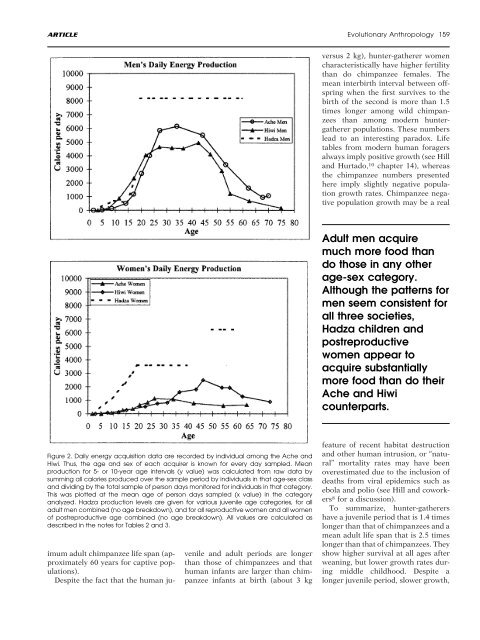A Theory of Human Life History Evolution - Radical Anthropology ...
A Theory of Human Life History Evolution - Radical Anthropology ...
A Theory of Human Life History Evolution - Radical Anthropology ...
Create successful ePaper yourself
Turn your PDF publications into a flip-book with our unique Google optimized e-Paper software.
ARTICLE <strong>Evolution</strong>ary <strong>Anthropology</strong> 159<br />
versus 2 kg), hunter-gatherer women<br />
characteristically have higher fertility<br />
than do chimpanzee females. The<br />
mean interbirth interval between <strong>of</strong>fspring<br />
when the first survives to the<br />
birth <strong>of</strong> the second is more than 1.5<br />
times longer among wild chimpanzees<br />
than among modern huntergatherer<br />
populations. These numbers<br />
lead to an interesting paradox. <strong>Life</strong><br />
tables from modern human foragers<br />
always imply positive growth (see Hill<br />
and Hurtado, 10 chapter 14), whereas<br />
the chimpanzee numbers presented<br />
here imply slightly negative population<br />
growth rates. Chimpanzee negative<br />
population growth may be a real<br />
Adult men acquire<br />
much more food than<br />
do those in any other<br />
age-sex category.<br />
Although the patterns for<br />
men seem consistent for<br />
all three societies,<br />
Hadza children and<br />
postreproductive<br />
women appear to<br />
acquire substantially<br />
more food than do their<br />
Ache and Hiwi<br />
counterparts.<br />
Figure 2. Daily energy acquisition data are recorded by individual among the Ache and<br />
Hiwi. Thus, the age and sex <strong>of</strong> each acquirer is known for every day sampled. Mean<br />
production for 5- or 10-year age intervals (y value) was calculated from raw data by<br />
summing all calories produced over the sample period by individuals in that age-sex class<br />
and dividing by the total sample <strong>of</strong> person days monitored for individuals in that category.<br />
This was plotted at the mean age <strong>of</strong> person days sampled (x value) in the category<br />
analyzed. Hadza production levels are given for various juvenile age categories, for all<br />
adult men combined (no age breakdown), and for all reproductive women and all women<br />
<strong>of</strong> postreproductive age combined (no age breakdown). All values are calculated as<br />
described in the notes for Tables 2 and 3.<br />
imum adult chimpanzee life span (approximately<br />
60 years for captive populations).<br />
Despite the fact that the human juvenile<br />
and adult periods are longer<br />
than those <strong>of</strong> chimpanzees and that<br />
human infants are larger than chimpanzee<br />
infants at birth (about 3 kg<br />
feature <strong>of</strong> recent habitat destruction<br />
and other human intrusion, or “natural”<br />
mortality rates may have been<br />
overestimated due to the inclusion <strong>of</strong><br />
deaths from viral epidemics such as<br />
ebola and polio (see Hill and coworkers<br />
8 for a discussion).<br />
To summarize, hunter-gatherers<br />
have a juvenile period that is 1.4 times<br />
longer than that <strong>of</strong> chimpanzees and a<br />
mean adult life span that is 2.5 times<br />
longer than that <strong>of</strong> chimpanzees. They<br />
show higher survival at all ages after<br />
weaning, but lower growth rates during<br />
middle childhood. Despite a<br />
longer juvenile period, slower growth,
















